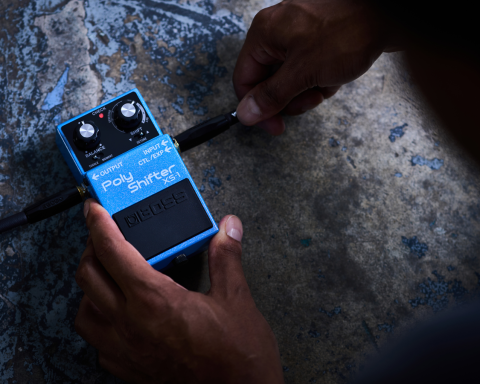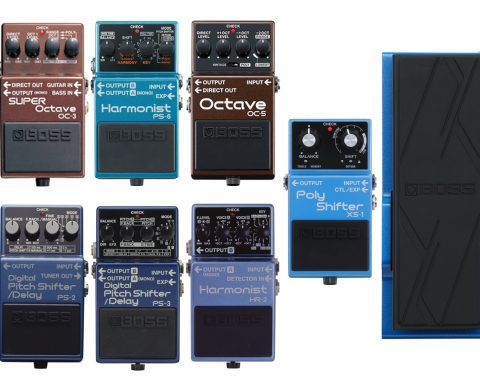Musicians can be a fussy bunch. Some prefer the minute details digital delay can offer, and others like the subtle nuances and unpredictability of analog delay. Some love both. We like what we like. One thing’s for certain: it doesn’t matter where you stand regarding analog vs. digital delay guitar pedals. Both have their place on all boards. Explore the differences between analog and digital delay pedals, their pros and cons, and whether or not you can use both delay types on your board. Hint: you can.
A (Very) Brief History of the Delay Pedal
The invention of the compact digital delay pedal by BOSS changed effects pedals forever, offering an unprecedented level of control and versatility that players expect today. We’re lucky that any delay sound you want is available in pedals like the DD-200 and DM-101.
In 1973, when Roland’s legendary Space Echo tape delay unit was unleashed upon the world, guitarists’ and studio engineers’ lives changed forever. The Space Echo became the industry-standard tape echo machine studios and musicians everywhere relied on. Soon, there was a call to create a smaller, pedalboard and gig-friendly option guitarists could take to a gig, add to their live rig, and not worry about tape running out.
BBD and Digital Arrive
Flash forward to 1978 and the birth of the DM-1 Delay machine: a cost-effective, highly portable, and extremely reliable pedal. The analog DM-1 had a warm, beautifully nuanced sound, providing delay times of up to 500 milliseconds. This made it highly appealing to musicians who wanted longer delay times and the ability to fine-tune delay effects on the fly. The DM-2 appeared in 1981, featuring a bucket-brigade device (BBD). It had a reduced delay of 300 ms but an even smaller footprint in the form of what we now know as the stompbox. But again, we guitarists always want more.
"The analog DM-1 had a warm, beautifully nuanced sound, providing delay times of up to 500 milliseconds."
With guitarists needing longer delay times and higher fidelity sound for stage and studio, BOSS knew it was time to digitize the world of delay pedals. 1983 marked the birth of the DD-2, the world’s first digital delay in stompbox form. It was also the first digital pedal of any type from BOSS.
The DD-2 provided higher fidelity sound and a max delay time of 800 milliseconds with a clear yet warm tone that analog players appreciated but with digital functionality and reliability. It revolutionized the world of delay pedals and set the standard for delay FX pedals. Neither replaced the other. Guitarists just had more choice when it came to delay pedals. Let’s dig into the technical details.
Types of Delay Pedals
Analog and Digital Delay Pedals: Technical Differences
The main difference between analog and digital delay pedals is analog delay pedals use Bucket Brigade Device (BBD) chips to create delay effects. By contrast, digital delay pedals use digital processing to replicate the sound. For instance, the DM-2W is a classic analog delay pedal that uses BBDs to produce its signature warm and rich delay, slightly degrading each time. The DD-200 uses digital processing so the delay sounds the same for as long as the player wants. This delay pedal glossary will help you understand key delay terms.

Is Analog Delay Better than Digital?
In short, analog delay is better if you like warm, organic, slightly unpredictable repeats. Digital is better if you want MIDI-accurate delay that is crisper, cleaner, and up to the millisecond accurate every time.
Both delays have their place; it just comes down to your desired sound. As always, there are no rules when it comes to music. Everything boils down to one’s preference and the sound you aim for. Here are some good questions to ask when choosing a delay pedal:
- Do I like the sound of organic delay that slightly degrades each time? Think of bands like Radiohead, Band Of Horses, U2, Pink Floyd, or The Verve.
- Do I prefer the sound of exact delay times with MIDI-accurate triggering? Think of bands like Periphery, Animals As Leaders, Monuments, Polyphia, and Guns N’ Roses. Slash pioneered the use of the DD pedals during the intro to “Welcome To The Jungle.”
For absolute precision, go for digital delay. However, if you seek delay with a life of its own and subtle degradation each time, try analog.

"The DM-2W is a go-to for a vintage, nostalgic tone, and the DM-101 is a great choice for a handful of different delay sounds in one pedal."
Analog Delay Pedal Examples
Two superb BOSS analog delay pedals are the DM-2W and the DM-101 Delay Machine. Both use bucket brigade device chips to offer the rich character of analog delay.
The DM-2W is a go-to for a vintage, nostalgic tone, and the DM-101 is a great choice for a handful of different delay sounds in one pedal. For example, the DM-101 has 12 different delay modes built-in, including:
- Classic—Traditional warm analog delay sound extended with up to 1200 ms of delay time
- Vintage—Retro analog delay sound inspired by the iconic BOSS DM-2 Delay pedal introduced in 1981
- Modern—Uniquely clear analog delay sound with a distinctive high-end tone and up to 840 ms of delay time
- Multi-Head—Emulates a multi-head tape delay while imparting a uniquely analog BBD sound character
- Non-Linear—A unique effect that produces consecutive short delays (35–190 ms) that gradually increase in volume
- Ambience—Simulates a small space
- Reflect—A stereo delay sound that produces a reverb-style effect
- Doubling+Delay—A stereo effect that combines a doubled sound with a longer delay
- Wide—A stereo delay with offset left/right delay times for an expansive sound
- Dual Mod—A stereo delay with different modulation phase settings on the left and right outputs
- Pan—A tapped stereo delay with different delay times distributed across the sound field
- Pattern—Stereo delay with different rhythmic patterns
Digital Delay Pedal Examples
One of the most popular BOSS digital delay pedals is the DD-3T. It offers three specific millisecond settings and the ability to adjust delay parameters.
With a delay time of 12.5 to 800 ms, divided into three ranges for quick setup, the DD-3T also allows you to tap in tempos using either the onboard pedal switch or an external footswitch. Additionally, it includes a Short Loop setting for creating phrase loops. This is similar to the Hold function on the original DD-3, and a direct output feature for sending dry and wet sounds to separate amplifiers. It’s a workhorse digital delay pedal with everything you need and nothing you don’t.
"One of the most popular BOSS digital delay pedals is the DD-3T. It offers three specific millisecond settings and the ability to adjust delay parameters."
If you need MIDI connectivity and triggering and multiple delay times, the DD-200 is an excellent choice. The DD-200 pedals offer class-leading sound quality with 32-bit AD/DA conversion, 32-bit floating-point processing, 96 kHz sampling rate, and twelve versatile modes that provide a wide array of delay types.
Designed for fast and easy operation with hands-on controls, you can access 128 setups from the panel or via MIDI program changes. Plus, players can recall consecutive memories and real-time panel settings with a footswitch or a dedicated panel button. The DD-200 digital delay also features a phrase looper with up to 60 seconds of recording time. Its delay modes include:
- Standard—Clear digital delay, PARAM adjusts the delay attack
- Analog—Emulates classic analog BBB delays like the BOSS DM series
- Tape—Emulates the warm tape-based sound of the legendary Roland RE-201 Space Echo
- Drum—Models the drum-based Binson Echorec 2
- Shimmer—Pitch-shifted delay for lush, heavenly textures
- Tera Echo—Spacious, animated ambience effect derived from the BOSS TE-2 pedal
- Pad Echo—Newly developed delay sound for creating drifting ambient textures
- Pattern—Rhythmic sounds with 16 delay lines layered together
- Lo-Fi—Delay sound with fat, distorted character
- Dual—Two different delay lines connected in series
- Reverse—Backwards delay for cool psychedelic effects and other unique tone
- Ducking—Delay with a built-in ducking effect
"Incorporating both delay types in a guitar or bass setup can offer a broader range of delay sounds."
Using Both Analog and Digital Delay Pedals
Incorporating both delay types in a guitar or bass setup can offer a broader range of delay sounds. You might use an analog delay like the DM-2W for a warm, vintage tone and a digital delay like the DD-8 for precise, rhythmic delays. You can’t go wrong with having both. Many players use multiple delays on their pedalboard for their essential uses. The BOSS DD-3T offers tap tempo accuracy and the DM-2W delay for when things need more breathing room and spontaneous “life” in the repeats.
The subtle nuances of analog are perfect for guitar solos or during a bridge. It changes slightly every time and acts differently. However, digital delay pedals provide absolute accuracy and ensure the tempo is the same at every gig for intros or locking in with the snare drum.
Pros and Cons
The pros and cons of digital and analog delays come down to two main aspects. Analog delays, like the DM-2W, have warm, musical echoes but lack the precision and versatility of digital delays. Digital delays, like the DD-8, offer many delay times and high-fidelity repeats but can sound too pristine for some tastes. Remember, there are no good or bad qualities. Both types are versatile, and you can enjoy the qualities of each in their own right.
Analog Pros
- Warm sounding
- Subtle nuances
- Natural modulation
- Delays degrade slightly each time
Analog Cons
- Less accurate than digital delay
- Can self-oscillate if pushed too hard
Digital Pros
- Accuracy of delay time to the millisecond
- No quality degradation
- Pristine, clean sound
Digital Cons
- Too clean sounding for some
- Won’t hide playing mistakes
"Remember, there are no good or bad qualities. Both types are versatile, and you can enjoy the qualities of each in their own right."
Powering Multiple Delay Pedals
When powering multiple pedals, ensure the power supply (a standalone AC adapter or pedal power supply “brick” style) can handle the combined current draw. For instance, the DD-8 draws 70mA, while the BOSS DD-200 draws 225mA. A 9-volt AC adapter can supply both of these. However, you must ensure your power supply has the correct current draw. If you don’t provide the correct mA, your delay won’t work correctly, and if you put too much voltage into it, you risk blowing it up. Always remember the following:
- Too Much mA (draw) = Pedal only draws what it needs
- Too Little mA = Pedal won’t work
- Too Much Voltage = Pedal might blow up
- Too Little Voltage = Pedal won’t work

Signal Chain
Delay pedals come at the end of the chain since they manipulate the signal and mimic an environment. If you place a delay before a fuzz, the sound is harder to control, and the delay effect affects the fuzz rather than working with it. The delay should have the final say in the sound.
AD Conversion
Placing an analog pedal like the DS-1 distortion or another delay like the DM-2W after might not preserve the analog tone. Try putting a digital delay at the end of the chain and allowing the analog tones to shine before the digital delay works with it.
"Delay pedals come at the end of the chain since they manipulate the signal and mimic an environment."
Both analog and digital delay pedals, like the analog DM-2W and DM-101 and digital DD-3T and DD-200, have unique strengths and can be incredible additions to your pedalboard, live, or studio rig. The choice between analog and digital delay pedals depends on personal preference and the sound one seeks. So, plug in, play on, and let the echoes guide your journey.






